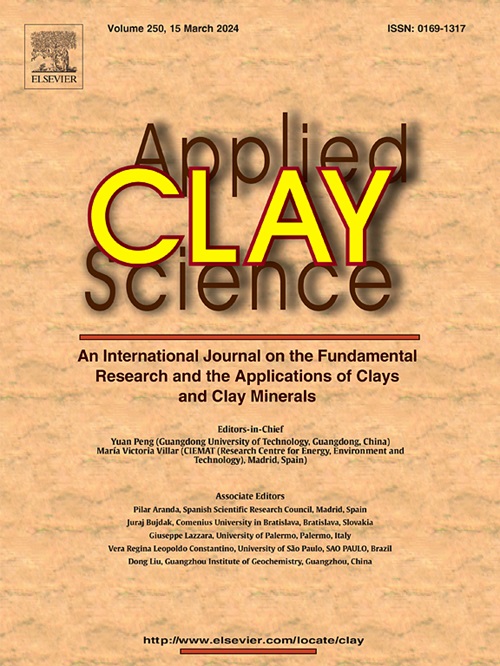Construction of hierarchically structured Bi2MoO6/g-C3N4/kaolinite S-scheme heterojunction photocatalyst for the efficient removal of formaldehyde and tetracycline under visible light
IF 5.8
2区 地球科学
Q2 CHEMISTRY, PHYSICAL
引用次数: 0
Abstract
A novel hierarchically structured Bi₂MoO₆/g-C₃N₄/kaolinite ternary S-scheme heterojunction photocatalyst was synthesized by a simple calcination crystallization and solvothermal method, with exfoliated kaolinite as the carrier. Detailed analysis of the structure and morphology of the composite was conducted through a series of characterization techniques. The results indicate that the incorporation of kaolinite notably enhanced the photocatalytic performance of the composite. Kaolinite not only acts as a carrier, providing a high specific surface area and abundant adsorption sites, but also facilitates the migration and separation of photogenerated carriers through its unique layered structure and surface chemical properties. Consequently, this ternary composite exhibits excellent degradation performance towards tetracycline and formaldehyde under visible light irradiation, with reaction rate constants that are 15.5 times and 8.05 times higher than that of pure g-C₃N₄, respectively. Radical scavenger experiments reveal that hydroxyl radical (•OH) is the primary active specie. Finally, we discuss the synergistic mechanism of kaolinite in the composite, including its enhancement of light capture ability, improvement of charge separation efficiency, and promotion of active species generation. Overall, this study provides new insights for developing highly efficient and stable kaolinite-based visible-light-driven materials for environmental remediation.

Bi2MoO6/g-C3N4/高岭石s型异质结光催化剂的构建及其在可见光下对甲醛和四环素的高效去除
以脱落的高岭石为载体,采用简单的煅烧结晶和溶剂热法合成了新型分层结构的Bi₂MoO₆/g-C₃N₄/高岭石三元s型异质结光催化剂。通过一系列表征技术对复合材料的结构和形貌进行了详细的分析。结果表明,高岭石的加入显著提高了复合材料的光催化性能。高岭石不仅可以作为载体,提供高比表面积和丰富的吸附位点,还可以通过其独特的层状结构和表面化学性质促进光生载体的迁移和分离。因此,该三元复合材料在可见光照射下对四环素和甲醛表现出优异的降解性能,反应速率常数分别是纯g-C₃N₄的15.5倍和8.05倍。自由基清除剂实验表明,羟基自由基(•OH)是主要的活性物质。最后,我们讨论了高岭石在复合材料中的协同作用机理,包括增强光捕获能力、提高电荷分离效率和促进活性物质的产生。总之,本研究为开发高效稳定的高岭石基可见光材料用于环境修复提供了新的思路。
本文章由计算机程序翻译,如有差异,请以英文原文为准。
求助全文
约1分钟内获得全文
求助全文
来源期刊

Applied Clay Science
地学-矿物学
CiteScore
10.30
自引率
10.70%
发文量
289
审稿时长
39 days
期刊介绍:
Applied Clay Science aims to be an international journal attracting high quality scientific papers on clays and clay minerals, including research papers, reviews, and technical notes. The journal covers typical subjects of Fundamental and Applied Clay Science such as:
• Synthesis and purification
• Structural, crystallographic and mineralogical properties of clays and clay minerals
• Thermal properties of clays and clay minerals
• Physico-chemical properties including i) surface and interface properties; ii) thermodynamic properties; iii) mechanical properties
• Interaction with water, with polar and apolar molecules
• Colloidal properties and rheology
• Adsorption, Intercalation, Ionic exchange
• Genesis and deposits of clay minerals
• Geology and geochemistry of clays
• Modification of clays and clay minerals properties by thermal and physical treatments
• Modification by chemical treatments with organic and inorganic molecules(organoclays, pillared clays)
• Modification by biological microorganisms. etc...
 求助内容:
求助内容: 应助结果提醒方式:
应助结果提醒方式:


